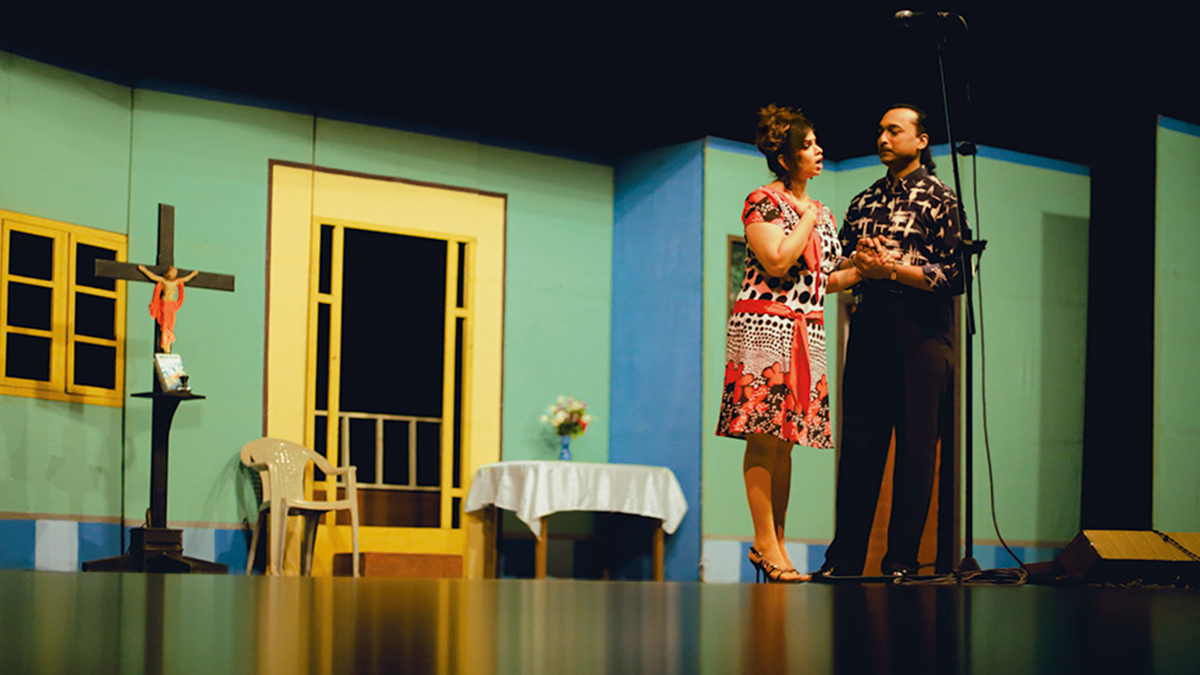Easter Sunday, April 17, 1892 is generally regarded as the date on which the first documented performance of a modern Goan tiatr was staged.
Italian Bhurgo (The Italian Boy), the first ‘Goan tiatr’, as this form of Konkani stage-based entertainment was then called, was enacted on that day in Bombay, at the New Alfred Theatre, which existed where the present Police Commissioner’s Head Office is located.
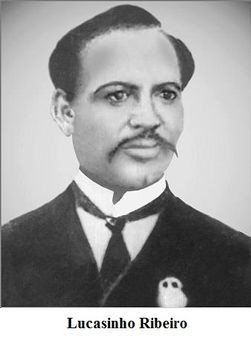
This play was composed by Lucasinho Ribeiro. Ribeiro had landed in Bombay from Goa in search of employment. He was proficient in English, knew music and could play the violin. He was a good composer and singer. Hence he could understand and appreciate operas being performed by an Italian opera company whose tour coincided with his arrival in Bombay.
Impressed by the presentation, he attempted to obtain a job as a stagehand with the troupe. He travelled with this Italian opera company to Poona, Madras, Shimla and Calcutta. When the troupe proceeded to Burma, Ribeiro parted company and returned to Bombay, but not forgetting one of their operettas. While leaving this job, he purchased the velvet costumes of the opera company in the hope that he might eventually be able to utilise them in his own venture.
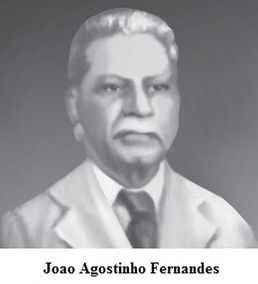
He composed Italian Bhurgo (The Italian Boy) on the basis of the Italian operetta and staged it as a Goan tiatr with the assistance of Joao Agostinho Fernandes, Caitaninho Fernandes, Agostinho Mascarenhas and another unidentified person. It was not easy to stage the drama. They had to struggle to get actors for the play as there was a strong bias against plays in Konkani due to the prevailing opinions against Khells and Zagors (indigenous folk theater of Goa). Ultimately five actors had to take the roles of nine characters. It was easier to get musicians as a large number of Goans, trained in the Escola de Musica (music schools in the parishes in Goa) were actively performing in Bombay at this time. This performance, however, was not the fruition of just a random creative impulse of Ribeiro. The development of theatre in Konkani must be traced back to several centuries, and its development as a language still earlier.
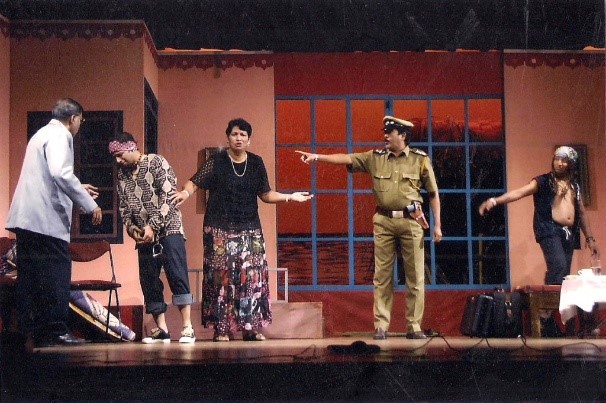
How many types of tiatr are performed?
Goa had traditions — imported and native — of festivities associated with religious celebrations. Such festivities included the staging of plays of a spiritual, moral or secular nature. Just as Mystery and Miracle plays or Morality plays, Passion plays and Biblical or Lenten enactments were performed in Europe, they were also performed in Goa. The Portuguese colonists and religious missionaries brought along with them their own cultural, spiritual, and catechetical practices. The earliest documented evidence of a performance of theater in Goa comes from the early sixteenth century.4
References are found to the staging of many tragedies, comedies and tragi-comedies on religious themes by the church in Goa. There were performances of Passion plays and dialogues on religious themes. The correspondence of the Jesuits in Goa with their superiors in Rome and Lisbon contains brief accounts of such performances. The language used in the performances was Latin. The purpose of the staging was to demonstrate the achievement of the native seminarians to the civil and ecclesiastical authorities, to propagate faith, and to provide wholesome diversion.
Religious drama, in early times…
Besides these dramas in Latin and Portuguese, religious plays in vernacular languages were staged on festive occasions such as Christmas, Easter and Corpus Christi. Passion plays were enacted during Lent. A play, in vernacular, performed in 1586 on the feast of St. Paul’s conversion (January 25) at the College of St Paul in the City of Goa seems particularly noteworthy because of its connection with the form of the medieval spectacle and pageant plays of Europe. The play described as a “short and gay dialogue on conversion to Christianity” was performed to celebrate the baptism of native neophytes.
The season of Lent is particularly noted for religious plays. The performances involved live actors and dialogue. However, when the government passed on the burden of the church expenses to the local communities, beginning in the seventeenth century, the staging of such performances seems to have suffered a decline. The “Stations of the Cross” [re-enactment of the final hours leading to the crucifixion of Christ in fourteen incidents] continue to be enacted even to this day, just as they were enacted centuries ago.
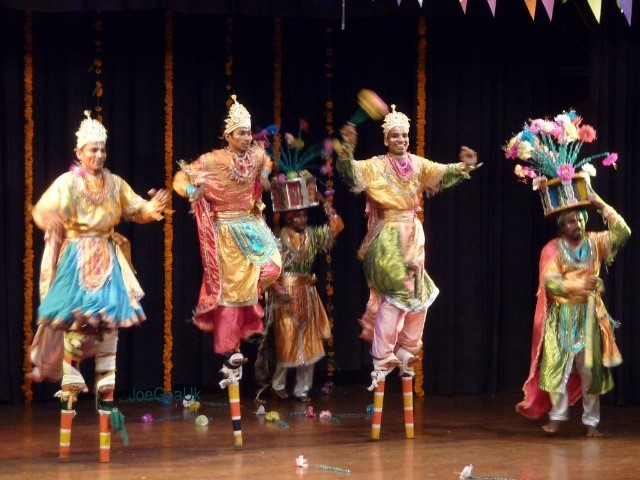
Secular drama for the rest of the year
While the religious enactments may have been generally staged during the major liturgical seasons of Advent, Lent and Easter, performances of a secular nature were held during the rest of the yeyea
Evidently, there existed in Goa a history of theatrical performances in European languages — mainly Portuguese, but also in French and Spanish — from the seventeenth to the nineteenth century. Most of these performances would have been generally restricted, being written, staged and acted by the elite.
In one of the earliest available issues of the Portuguese-language weekly O Ultramar (July 18, 1861, archived in the Central Library, Panjim) there is a notice for a Goan tiatr being performed by a “band of curious young men… at the house of Padre Mestre Pacheco in the hall where at one time classes of Latin were held….”.
An example of the early Goan tiatr in Portuguese written by a Goan is the play Os Dois Irmãos Doidos e As Duas Meninas Vizinhas (The Two Mad Brothers and the Two Neighbouring Girls), by Inacio Custodio Coelho in 1866. It was staged at the Teatro Harmonia, Margao.
Other examples of local Portuguese language teatro are works of Joaquim Filipe Neri Soares Rebelo (1873-1922), whose Obras Completas in three volumes were published by his son in Mozambique in 1973.7 Volume 1 contains O Rei-Milhão, a comedy drama in two acts (performed at Margao 1900), O Peixote, comic monologue (performed at Verna 1895, and Margao 1904), Efeitos da Pinga, comedy in one act (performed at Nova Goa 1906), O Senhor Serapião, comic sketch (performed at Margao in 1908), Tempestade em Copo de Água, comedy in one act (performed at Margao in 1908), Os Dois Namorados, comedy in one act (performed at Margao in 1909), and Mogarem, a historical drama in four acts (performed at Margao in 1910 and at Coimbra in 1912).
The performances of Portuguese language tiatr appear to be more urban-based and bourgeois-centred. Incidentally, the early performances of Konkani Goan tiatr were styled as tiatr and the first troupe, which performed Italian Bhurgo in Bombay in 1892, called itself the Goa Portuguese Dramatic Company
Indigenous traditions: Goa’s folk performances
There were also other indigenous traditions that must be taken into account. Among these indigenous performances were zagor, and khell or phell or fell.
Zagor comes from the word jagar, a Hindu performance genre in Goa. The word jagar is in turn derived from Sankrit and refers to a vigil or wakefulness or nightlong performance. Jagran and zagronn are the Konkani words for ‘a vigil’. The name highlights the purpose of the participants to stay awake for a full night in order to honour and worship a particular local pantheon of ancestors, gods, saints, and spirits. The zagor combines religious ritual with the performance of dance, song and theatre.8
Among the more strictly speaking religious activities, the most important one is the singing of the naman, i.e. hymns of homage. Collectively sung by a group of men known as the manddkari, i.e. the ‘dignitaries’ of the village or those who are on the mandd committee, these hymns individually invoke all ancestors, gods, saints, and spirits who are related with the village in a ritually relevant manner requesting them to grant their benevolence and protection for a full year ahead.
The festivals open between 10 p.m. and midnight and close at daybreak. Sumptuously costumed men and boys perform, on a sort of stage, a series of ten to fifty plots, which are known as soungam, meaning ‘characters’. The plots are enacted through dance, song and theatrical acting and stage a great variety of themes and figures. Next to mythical and semi-divine characters such as ‘kings’, ‘queens’, ‘ascetics’, ‘heroes’ and ‘demons’ — whose names and stories often allude to well known episodes in famous epics such as the Mahabharata and Ramayana — come characters of various social groups.
Members of caste or occupational groups such as ‘bakers’, ‘barbers’ ‘gardeners’, ‘washermen’ and ‘students’ can be seen in interaction with officials and authorities like the ‘village headman’, the ‘town crier’, the ‘tax collector‘, the ‘village brahmin’, ‘policemen’ and ‘soldiers’. The often ironic and ridiculed representation of these figures continues when characters representing gender or kinship positions are staged. Hence, the portrayal of precarious situations, appropriate behaviour, and relations with erotic overtones prevails also in the dialogues between ‘wives’ and ‘husbands’, ‘parents’ and ‘daughters’, ‘uncles’ and ‘nephews’. Especially appreciated by the audiences, these themes sometimes allude to real persons and events of the society and imply ‘critical comments on local, national and occasionally even global politics’.
Some of the characters can be classified as ‘strangers’. Examples of these are Khan Saib, the ‘Muslim merchant’; Firanghi, the ‘foreigner’ who has become synonymous for the historical European; Kapro, Khapri or Hapshi, the ‘African’ who was formerly brought to India as a slave; Paklo, the historical ‘Portuguese’ who for some embodied an equivalent of any white man, and in some festivals a hippie, the representative of the international backpacker tourists who started frequenting Goa’s beaches since the 1960’s and who in the jagar or zagor play usually are depicted rather scantily dressed and with a somewhat strange, drug-influenced behaviour.
Amongst the Hindus, there are two distinct kinds of jagar performances: Perni jagar is a ritual performance of the Perni community in temples and the Gavda jagar is performed by members of the aboriginal Gavda tribe for the entertainment of the village.
Zagors were performed at the time of certain village feasts and church festivals, sponsored by the village community as a whole. The expenses for these performances were contributed to by common village funds. The audience and the performers of zagor were co-celebrants and not patrons and beneficiaries. The people would gather at an open place. A fire was made at the centre of the area. The audience would sit around, keeping free the space required for acting. Though zagors were also performed in Salcete, they were more popular in the Christian villages of Siolim, Calangute and Candolim in the Bardez sub-district. They were very similar to the Gavda jagar of the Hindus and consisted of a series of appearances of caricatured stereotyped characters from village life as well as characters from the world of fantasy.
There was no theme or story but each character represented its essence through song and dance — sometimes there was rudimentary and ribald exchange between two characters. Acting in zagors was mostly extempore. The actors had liberty in their actions and speech including open criticism of others. The criticized person could also, through his performance, give a befitting reply to the critic.
Vulgarity used to play an important role in the zagors. Even references to extra-marital affairs or village gossip could figure in the zagor. Sometimes the dialogues would comprise of a slinging match. There were no rehearsals, no script, no direction but the zagor did entertain the people at that time.
The musical accompaniment consisted of the indigenous ghumot, a quasi-semi-circular earthen vessel, the front covered with monitor lizard skin, the bottom an open tube. Another instrument used was the madlem, a cylindrical earthenware vessel.
The zagor has been recognized as the earliest form of Konkani drama in Goa, staged by the indigenous Gavda community.
Zagors in Bombay with the migrants
When the first Goan migrants settled in Bombay in the early nineteenth century, they also performed zagors as a part of their cultural life. The Goan emigrant population in Bombay provided the participants as well as the audience for such cultural activities.
Those who were not provided with living quarters at the workplace usually resided in the “room” or village club (coodd or coor). Separate clubs were set up for ladies. In some clubs there was even a provision for a family room, which could be booked for about a week at a time. Seamen and those going abroad for employment, found this arrangement very convenient as they did not have to be separated from female members of their family who came to receive them on their return from abroad or see them off.
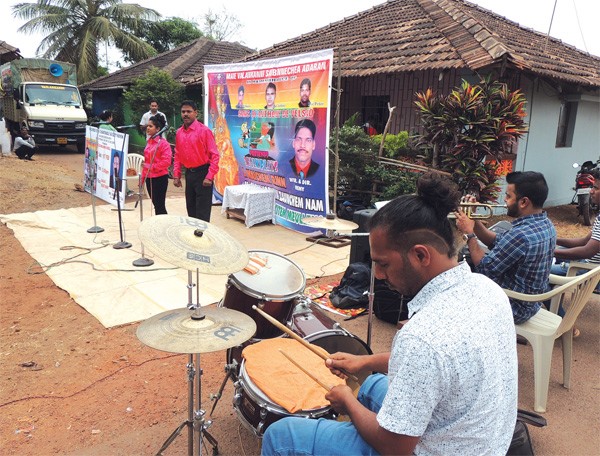
Life in the club also kept alive the local Goan traditions such as evening prayers (the Angelus, the Rosary and the Litany), Goan cuisine and celebrations of feasts followed by entertainment in the form of dances or theatrical performances. The clubs fulfilled the responsibility of functioning like the mand in Goa. The organisation and expenses for the ritual performances such as zagor were the responsibility of a unique Goan village institution called the mandd.
Mandd is the name for an open place in the village, which through traditional usage has become sanctified. It is the area used for the inaugural worship, which precedes ritual performances such as zagor and Mussallam Phell amongst the Christians, and Shigmo and Dhalo (variation of Dhavalgit) amongst the Hindus. Mand means to arrange. Mand also refers to the ‘table’ (mez) or committee responsible for undertaking public duties and functions or raising funds for common celebrations as above. In Bombay, the emigrants entrusted the club with the functions and responsibilities of the village mand. Such emigrants became the participants as well as the audience for the various cultural enactments. Sometimes they invited their employers and well wishers.
There were about five hundred such Goan clubs in Bombay. Many of the Goan clubs were situated in the Marine Lines-Dhobitalao area. There were also some in the Mazagaon area. A club was like ‘a home away from the village’. It provided a convenient social support system for the migrant workers and also helped to keep up ties with fellow villagers.
Although in Goa the Gavda community staged zagors primarily for its own members, in Bombay zagors were enacted initially by persons who worked as domestic servants, cooks and butlers.
Zagors were usually staged at Alfred Theatre, Bombay Skating Ring, Gaiety Theatre (the present Capitol Cinema), Novelty Theatre, Opera House and Victoria Theatre. The entire Goan expatriate community did not favour the zagor. In fact, because of the destructive criticism and vulgarities, high class people refrained from attending zagors. Gossip, illicit affairs of neighbours, rumours, and washing dirty linen in public formed the content of some zagors. Thus there has been a general impression that zagors were an unrefined form of entertainment. But all zagors were not crude. While some were in bad taste others were very good and entertaining.
Even Dadabhai Naoroji, the then Member of Parliament, attended a zagor show in December 1893 at the Victoria Theatre, Bombay. The theatre was electrified for the first time and specially illuminated for the occasion. The hall was packed to capacity for this performance.
Folk art forms of Christians in Goa: Zagor, Khell, Mussallam Phell, Mell
Zagors continue to be performed in Goa, more by the Hindus than by the Christians. The most prominent Christian zagor is the one organized at Siolim. The other place, which keeps up the tradition, is Calangute where the zagor is held during Easter. The joyous celebration of Easter provides the impetus for the resumption of the theatrical season after the abstinence practiced during the preceding Lenten season. Zagors undoubtedly prevailed on the Konkani entertainment scenario in Bombay and were quite definitely replaced by tiatr. But one must not forget the role of the other indigenous form of theatrical entertainment — the Khell or Phell or Fell, Mell.
Khell is a Sanskrit word, which means game, sport or play. In other areas of coastal Konkan, Khell and Khelle are names used for ritual dances performed by various village communities at the time of the Hindu festivals such as Holi. Amongst the Goan villagers the Catholics perform various kinds of Khells mostly at the time of the pre-Lenten Carnival. There are some that are performed at Easter and during the Christmas season. The most elaborate of these is the Mussallam Phell or Mussallam Khel (Pestle Dance) performed in the villages of Cotta, Chandor and Cavorim in Salcete sub-district on the second and third days of the Carnival.
Just as the Mussallam Khell is localised in Cotta and Cavorim, the Mell is unique in being limited to the Assolna and Velim area in Salcete. After invocatory prayers at the structure of the common Holy Cross, the participants dance to the accompaniment of a drum. This cultural practice actually serves to arrange a ‘meeting’ of the villagers (mell as a verb means “to meet”). Their relationships are maintained through their coming together from several villages.
The Carnival plays: Sketches of village life
There were, however, other kinds of Khells performed during the Carnival, again in the villages of the Salcete area. Till some thirty years ago, these Khells were performed commonly in villages such as Benaulim, Colva, Chinchinim, Varca, Nesai (Sao José de Areal) and Raia.
Khells were generally performed by roving troupes. A lot of improvisation went into the presentation of the Khell. Material props for the play were those that could be easily carried by the performers. Items of furniture would be borrowed from the patrons or sponsors where the performance was being held. In an open air staging the director would loudly announce the scene location and blow a whistle to indicate scene changes. Various elements of Khell indicate that they were among the earliest experimental plays in Goa. Some features of Khells such as the use of stock characters and masks, permit a comparison with the Commedia dell’arte which flourished in Italy in the middle of the sixteenth century and spread to the rest of Europe in the sixteenth and seventeenth centuries.
Over the decades, Khells have undergone much transformation. During the Portuguese rule, when censorship was in effect, the first show had to be performed at the residence or compound of the ‘Regedor’ (the equivalent to a village supervisor) for approval. Whereas earlier they used to be performed in the courtyard of a landlord or a wealthy sponsor, the troupes were subsequently invited to perform elsewhere such as compounds of bars and restaurants and even public places such as beaches. Now the troupes travel in motor vehicles and carry all their requirements including posters, costumes, furniture, band, sound systems and even the platforms, props and curtains to set up a stage. The themes now deal with the contemporary society and environment.
Contradança was similar to Khell, where the improvised material satirised the pomposity, and cupidity of the landlords. The landlords laughed at their own foibles but decorum was always maintained by the performers, which was lacking in a more boisterous public performance of the Khells.
The Zagors and Carnival Khells (with the notable exception of the Mussullam Phell and Mell which are community performances), and Contradança performances can be looked upon as precursors of modern Konkani theatre.

